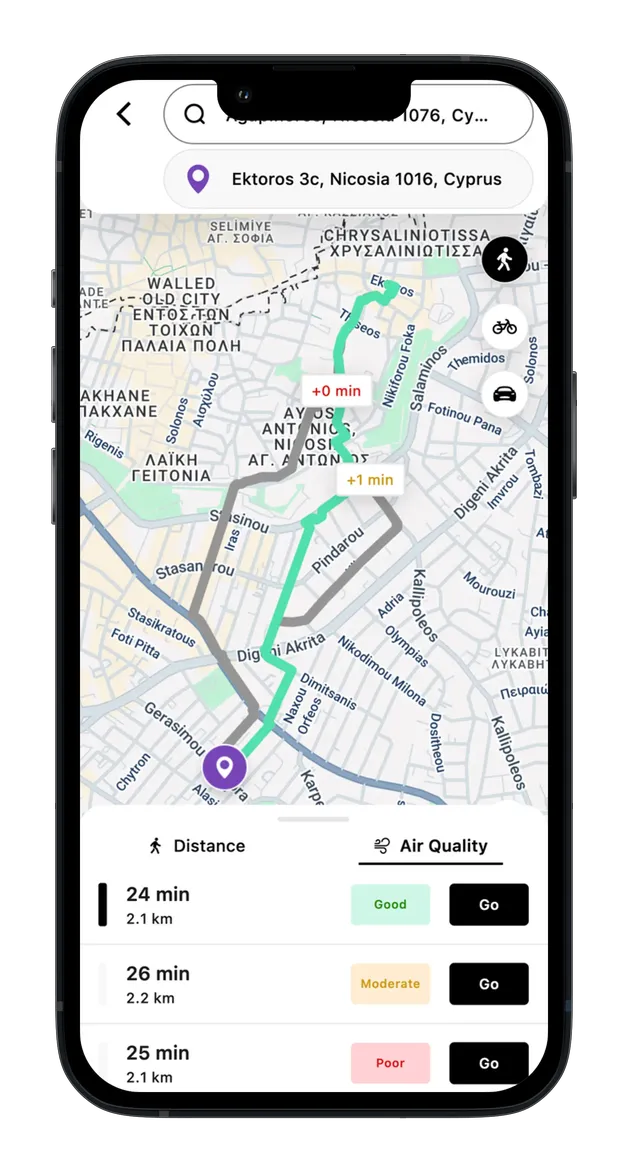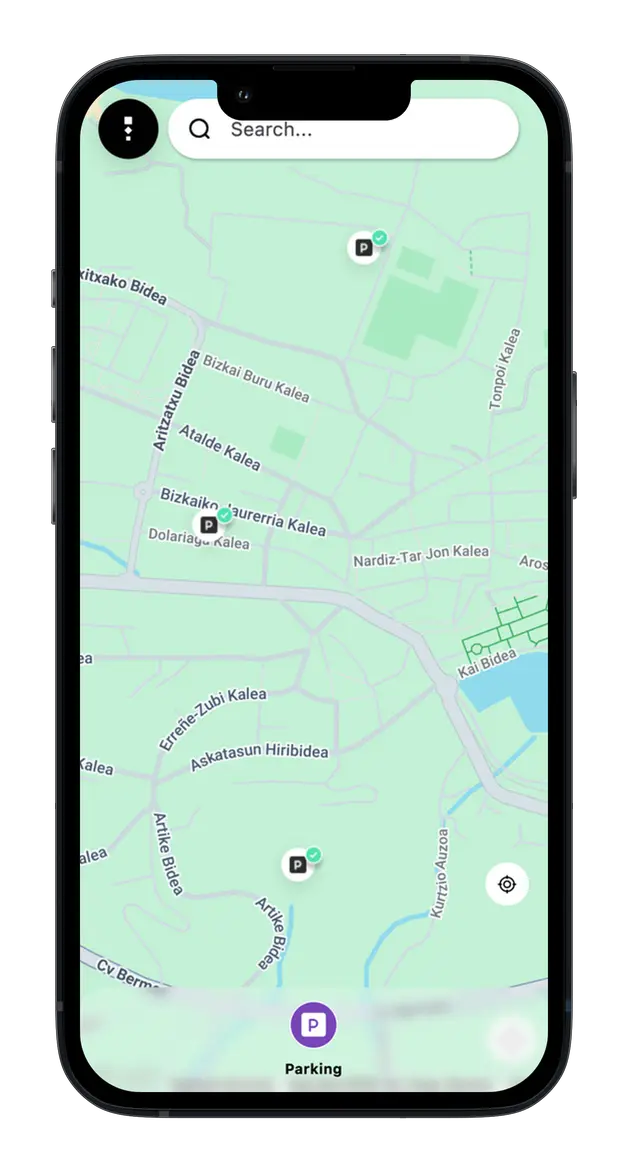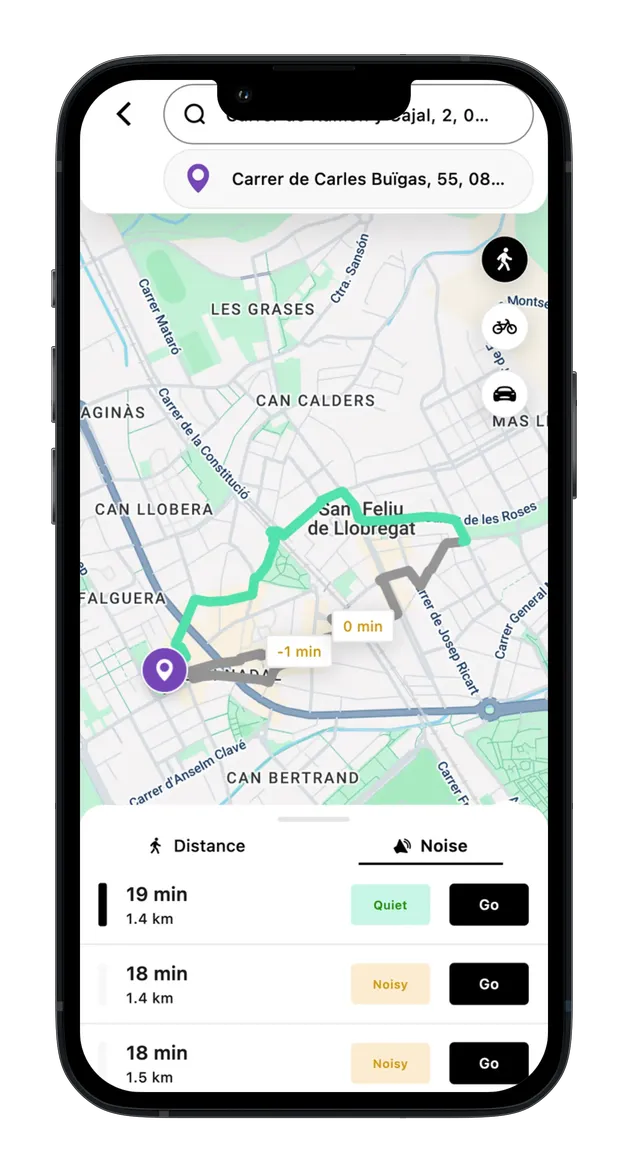Thinkz – Cities Use Cases
Discover how Thinkz transforms everyday urban challenges






Thinkz Use Cases Catalog
Discover our Real-Time Solutions for Cities
Environmental, Mobility, Affluence, Urban Facilities, Cultural & Touristic Places
 NICOSIA – CYPRUS
NICOSIA – CYPRUS
Real-Time Smart Waste & Air Quality
Insights:
The Smart Nicosia department is focused on encouraging residents and tourists to recycle more effectively, optimize waste collection, and reduce CO2 emissions. Their goal is to promote sustainable living and provide a healthier urban environment.
Problem:
How can Nicosia encourage better waste sorting, optimize garbage collection, and reduce CO2 emissions? How can the city offer citizens a more sustainable urban experience?
Solutions:
Real-Time Recycling Bin Status Monitoring
This advanced service is a game-changer in urban waste management. Using IoT sensors on recycling bins, it provides real-time updates on the status of bins across the city, labeled as available (green) or full (red). This ensures an environmentally friendly and health-conscious urban lifestyle by streamlining waste collection and reducing unnecessary trips for garbage trucks.
By efficiently managing recycling bin collections based on real-time fill levels, this service reduces operational costs and air pollution. It promotes active participation in recycling, ensuring that each trip to a recycling bin is efficient and environmentally responsible.
Real-Time Air Quality Routing
Connected to the recycling bin status monitoring is the real-time air quality routing service. This cutting-edge solution transforms urban navigation by offering routes based on real-time air quality measurements. Utilizing advanced IoT sensors throughout the city, it dynamically assesses air pollution levels, categorizing routes as green (low pollution), orange (moderate pollution), or red (high pollution).
This integration allows citizens to reach recycling bins through the paths with the best air quality, promoting healthier lifestyle choices by minimizing exposure to air pollution during their journeys. The benefits extend beyond waste management, enhancing overall urban living by guiding residents and visitors through areas with the best air quality.





BENEFITS USE CASE SMART NICOSIA
For Citizens & Tourists

Convenience: Quickly locate available recycling bins and navigate using real-time air quality data, making sustainable practices effortless.
Healthier Living: Avoid high-pollution areas by taking routes with the best air quality, reducing exposure to harmful pollutants and enhancing overall well-being.
Environmental Responsibility: Easily participate in recycling efforts and choose eco-friendly paths, fostering a culture of environmental stewardship.
For Municipalities
Cost Efficiency: Optimize waste collection routes with real-time bin status data, cutting down on fuel and labor costs. For example, cities of 200K Inhabitant can save up to €75,000 annually on fuel and €150,000 on labor.
Environmental Benefits: Lower CO2 emissions through efficient waste management and cleaner travel routes, helping cities meet sustainability goals. For instance, a city can reduce up to 1,280.3 tonnes of CO2 annually from optimized waste management alone.
Improved Public Health: Enhanced air quality leads to fewer respiratory issues, lowering healthcare costs and improving the quality of life.
Citizen Engagement: Providing reliable, AI-verified data builds trust in municipal services, increasing civic participation and satisfaction with city living.
 VILA-REAL – SPAIN
VILA-REAL – SPAIN
Real-Time Inclusive Mobility & Smart Parking
Insights:
Vila Real is determined to make every journey smoother and more inclusive. By giving residents, visitors and drivers with disabilities live visibility of buses, parking and attractions, the city aims to cut congestion, boost accessibility and highlight its cultural heart.
Problem:
How can Vila Real supply reliable, to-the-second information so citizens know where the bus is, where to park — especially in disabled bays — and how best to enjoy the historic centre without wasting time, fuel or patience?
Solutions:
Real-Time Public-Bus Tracking
IoT devices on each bus stream live positions and countdown ETAs into Thinkz widgets, so passengers leave home at precisely the right moment.
Disabled-Parking Location & Availability
Kerb-side sensors on every blue-badge bay push free/occupied status plus exact geolocation, guiding drivers with disabilities straight to a spot and eliminating frustrating loops.
Plaza Mayor Parking Insights
Occupancy sensors and barrier data display the current number of free spaces in the town’s busiest car park, rerouting motorists before they clog narrow streets.
Static Attraction Information
Geotagged cultural sites — museums, theatres, landmarks — surface opening hours, ticket links and accessibility notes (including nearby disabled bays), enriching each visit.





BENEFITS USE CASE VILA-REAL
For Citizens & Tourists

Stress-Free Journeys: Live bus ETAs and parking status remove uncertainty.
Inclusive Access: City-wide mapping of disabled bays ensures fair, first-time parking success.
Time Optimisation: Fewer detours mean more moments spent in Plaza Mayor and cultural venues
Cultural Discovery: Instant attraction details encourage deeper engagement with local heritage
For Municipalities
Massive CO₂ Cuts: Up to 11 166 t avoided each year through Parking Search Optimisation, plus 2 215 t from Real-Time Public Transport Insights—a combined 13 381 t shaved off your emissions ledger.
Climate-Target Compliance: These savings feed directly into Fit-for-55 and 2030/2050 neutrality milestones, reducing pressure from future carbon taxes.
Less Congestion, Better Flow: Fewer cars circling for spaces and better-timed bus journeys clear bottlenecks, shortening peak-hour delays.
Higher Public Satisfaction: Reliable, AI-verified information builds trust, boosts transport ridership and keeps citizen complaints out of the inbox
 BERMEO SPAIN
BERMEO SPAIN
Real-Time Smart Parking
Insights:
Bermeo, a scenic city in Spain, is known for its rich culture and historical landmarks, drawing residents and tourists alike. While its charm is undeniable, the influx of vehicles in the city creates parking challenges. Finding available parking spaces can become a tedious task, especially during peak hours or tourist seasons.
Problem:
This frequent search for parking not only intensifies traffic congestion but also extends the time visitors spend on the road, leading to increased air pollution and potential missed opportunities for local businesses, as some visitors may forgo their visit due to the parking dilemma.
Solutions:
By integrating Thinkz technology and harnessing the power of IoT devices within parking zones, Bermeo could now provide real-time data on available parking slots. This innovative approach is broadcasted through easily accessible digital platforms, guiding drivers directly to available spaces. This not only streamlines the parking experience but also enhances city navigation, saving time, reducing environmental impact, and indirectly boosting local commerce.


BENEFITS SMART PARKING BERMEO
For Citizens & Tourists

Convenience: Real-time information on available parking spots reduces the time spent searching for parking, making trips more efficient and less stressful.
Cost Reduction: Reducing the time spent searching for parking lowers fuel consumption and vehicle wear, translating into lower maintenance and operational costs.
Environmental Responsibility: By minimizing the time spent driving around looking for parking, CO2 emissions are significantly reduced, contributing to a cleaner environment.
Enhanced Experience: Fewer delays and a smoother parking experience improve the overall quality of urban travel, enhancing satisfaction for both residents and visitors.
For Municipalities
Increased Revenue: Higher occupancy rates in parking facilities lead to increased parking revenue, with potential annual additional revenue of up to €312,000 from optimized parking turnover for a city with 150 parkings.
Environmental Impact: Significant reductions in CO2 emissions, estimated at 3 532 kg annually, ( for a city of 16K inhabitants) align with sustainability goals and help meet regulatory requirements.
Operational Efficiency: Real-time data allows for dynamic adjustments in parking management, reducing congestion and improving the flow of traffic in urban areas.
Improved Public Health: Lower emissions contribute to cleaner air, reducing respiratory issues and enhancing public health.
Economic Growth: Efficient parking management supports local businesses by making it easier for customers to access shops and services, potentially increasing foot traffic and sales. Providing reliable, AI-verified data builds trust in municipal services, increasing civic participation and satisfaction with city living.
 WESTMINSTER LONDON CITY HALL
WESTMINSTER LONDON CITY HALL
Real-Time Air Quality Routing
Insights:
The Westminster London City Hall is focused on improving urban air quality and ensuring that both residents and visitors can navigate the city in the healthiest possible manner. Real-time data on air quality can guide citizens and tourists through the cleanest routes available.
Problem:
Westminster needs an effective solution to monitor and manage air quality in real-time, guiding pedestrians and cyclists away from high pollution areas and ensuring the well-being of its urban population.
Solutions:
The solution leverages advanced IoT sensors placed throughout Westminster to collect and analyze real-time air quality data. This data is assessed using the Air Quality Index (AQI), which categorizes levels as Good, Moderate, Unhealthy for Sensitive Groups, Unhealthy, Very Unhealthy, and Hazardous.
The Air Quality Routing feature offers pedestrians the ability to choose walking routes based on these real-time air quality measurements. Routes are dynamically categorized as green (low pollution), orange (moderate pollution), or red (high pollution), enabling users to make informed decisions for healthier travel.
By providing real-time updates and optimizing walking paths based on air quality, this solution helps residents and visitors minimize their exposure to polluted areas, promoting better respiratory health and overall well-being. Furthermore, it enhances the urban experience by making Westminster a more pleasant and healthier place to explore, supporting the city’s sustainability and environmental goals. This real-time data also aids urban planners and policymakers in making informed decisions to improve public health and reduce pollution, leading to lower healthcare costs and a higher quality of life for residents and tourists alike.





BENEFITS AIR QUALITY ROUTING
For Citizens & Tourists

Healthier Travel: Minimize exposure to polluted areas by choosing the cleanest routes, promoting better respiratory health and overall well-being.
Informed Decisions: Access to real-time air quality data empowers individuals to make health-conscious travel choices.
Enhanced Urban Experience: Walking in cleaner air enhances the overall experience of exploring Westminster, making it a more pleasant destination.
For Municipalities
Sustainability Goals: Encouraging walking routes through less polluted areas supports the city’s sustainability and environmental goals, potentially reducing overall air pollution.
Data-Driven Urban Planning: Real-time data on air quality can aid in urban planning and policy-making, improving the quality of life for residents and attracting more tourists.
Improved Public Health: Reducing exposure to polluted areas can decrease respiratory issues and other pollution-related health problems, leading to lower healthcare costs.
 SAN SEBASTIAN – SPAIN
SAN SEBASTIAN – SPAIN
Real-Time Smart Tourism, Sustainability, Citizens
Insights:
San Sebastián aims to transform into a smart, sustainable city by leveraging innovative real-time services. The city’s primary goals are to reduce CO2 emissions and enhance urban mobility, contributing to an overall improvement in residents’ quality of life while enhancing the experience for its numerous tourists.
Problem:
San Sebastián faces significant challenges with urban congestion and environmental sustainability. The city seeks to optimize its transportation systems, enhance public services, and promote eco-friendly practices among its citizens and tourists, all while maintaining a high standard of living and minimizing the carbon footprint.
Shared Bicycle AvailabilitySolutions:
Thinkz provides a comprehensive suite of real-time services to tackle these issues head-on, leveraging advanced IoT technology and AI-driven insights. This integrated solution includes:
Real-time Roads and Streets Crowdedness Monitoring
By monitoring crowdedness in real-time, this service reduces traffic congestion and suggests alternative routes, optimizing urban mobility and decreasing commute times.
Real-time Local Markets and Public Building Crowdedness Monitoring
Enhances the usage of public spaces by providing real-time data on crowdedness, thus improving safety, comfort, and space management.
Real-time Parking Availability
Guides drivers to available parking spots in real-time, reducing unnecessary driving, cutting down emissions, and alleviating the frustration of finding parking.
Real-time Air Quality Routing
Offers walking routes based on real-time air quality measurements. By categorizing routes (green for low pollution, orange for moderate, and red for high), it ensures citizens and tourists can choose healthier paths.
Real-time Shared Bicycle Availability
Promotes eco-friendly transportation by providing real-time data on the availability of shared bicycles, encouraging more sustainable urban mobility.
These solutions collectively empower citizens and visitors with actionable insights, enhancing urban life, reducing environmental impact, and supporting sustainable practices.





BENEFITS SMART TOURISM, SAN SEBASTIAN
For Citizens & Tourists

Healthier Travel: Minimizes exposure to pollution by choosing the cleanest routes, improving respiratory health and well-being.
Informed Decisions: Real-time data empowers individuals to make health-conscious and efficient travel choices.
Enhanced Urban Experience: Cleaner air and reduced congestion make exploring the city more enjoyable.
Eco-Friendly Transport: Promotes the use of shared bicycles, reducing reliance on cars.
For Municipalities
Improved Public Health: Lower exposure to pollutants decreases health issues, reducing healthcare costs.
Sustainability Goals: Supports the city’s goals of reducing CO2 emissions and promoting environmental sustainability.
Data-Driven Urban Planning: Real-time data aids in better planning and policy-making, improving urban management.
Optimized Resource Management: Efficient use of urban spaces and resources through real-time monitoring.
Increased Parking Revenue: Higher parking turnover reduces search time, lowers congestion, and boosts municipal revenue.
 SANT FELIU DE LLOBREGAT – SPAIN
SANT FELIU DE LLOBREGAT – SPAIN
Real-Time Noise Pollution Mapping & Routing
Insights:
Residents and tourists in Sant Feliu de Llobregat require real-time information on noise pollution to navigate the city more peacefully and enhance their urban experience.
Problem:
The city faces challenges with noise pollution affecting the quality of life for residents and visitors. Without real-time data, individuals cannot effectively avoid noisy areas, leading to increased stress and potential health issues.
Solutions:
This innovative service harnesses IoT sensors to capture and relay real-time decibel levels, mapping the city’s acoustic environment and guiding citizens and visitors along paths with the lowest noise pollution. It categorizes areas into serene (green), moderate (orange), and noisy (red) zones, empowering individuals to make informed decisions about their travel routes, thereby prioritizing tranquility and peace.
By providing real-time noise pollution data, the system enables residents and visitors to choose quieter routes for walking, cycling, or driving, enhancing their urban experience. The health benefits are significant; avoiding noisy areas can lead to better mental health and reduce the risk of hearing loss. This service also aids in urban planning by providing valuable data to identify and address noise pollution hotspots effectively. Integrating noise level data into urban planning can improve the design of green spaces, pedestrian zones, and infrastructure projects, fostering quieter city areas and boosting tourism by promoting the city as a peaceful, attractive destination for visitors seeking a serene urban experience.


BENEFITS LOW NOISE DETECTION ROUTING
For Citizens & Tourists

Healthier and Quieter Travel: Choose paths with lower noise pollution to improve mental health and overall well-being.
Enhanced Urban Experience: Enjoy a more tranquil city journey, making daily commutes and leisure activities less stressful and more enjoyable.
Informed Decisions: Real-time noise level data empowers individuals to select the quietest routes, enhancing their quality of life.
For Municipalities
Sustainability Goals: Encouraging walking routes through less polluted areas supports the city’s sustainability and environmental goals, potentially reducing overall air pollution.
Public Health Benefits: Reducing exposure to noise pollution can decrease stress-related health issues, improving the overall well-being of the community.
Economic and Tourism Growth: Promote the city as a peaceful destination, attracting tourists seeking a quieter urban experience, and boosting local businesses.
Cost Savings: Effective noise management can lead to lower healthcare costs and better resource allocation for urban development projects.
Thinkz’ News
Last Events and Articles
Follow the team in our last Events, Conferences, Workshops, or Shark tanks across Europe. Discover our last reflexion about the smart cities of tomorrow.






